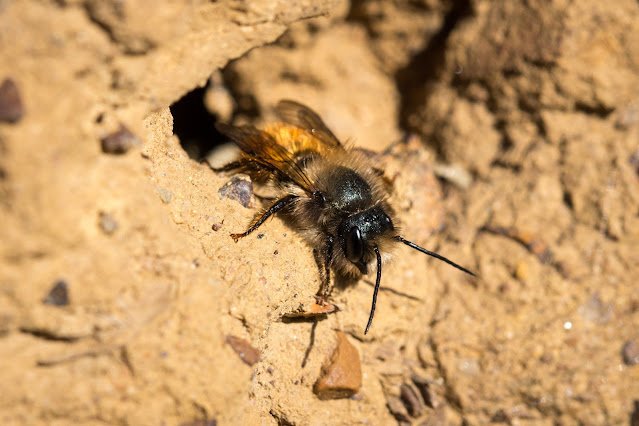I first wrote about the bees in this wall seven years ago. It is an old cob wall near the church in Nether Heyford, Northamptonshire, one of several similar walls in the village. The wall is hundreds of years old and is home to hundreds or even thousands of bees. They are all solitary bees and most are either hairy-footed flower bees (Anthophora plumipes), common mourning cuckoo bees (Melecta albifrons), or red mason bees (Osmia bicornis). When I visited a month ago most of the bees I saw were male hairy-footed flower bees, hanging about in the hope of finding a freshly emerged female. When I returned last weekend all the males had gone (having mated and died) and the females were busy provisioning their nests in the holes in the wall.
Back at the wall I found a spider that had just captured a cuckoo bee. The spider was also hiding in one of the holes and had built webs across several of the others. It was in the process of wrapping the bee, which was still alive, and then appeared to bite it, presumably with a venomous or paralysing bite.
I think this is probably a female noble false widow (Steatoba nobilis). This spider first appeared in Devon 150 years ago, having been imported from the Canary Islands in a consignment of bananas, and is now widespread across the southern half of the UK. For a description of the false widow spider and some amazing photos see Jason Steel's website.
Spring is later up here in the north so I hoped some of the local male A. plumipes would still be around. Yesterday I was in Morpeth, 10 miles north of here and 230 miles north of my mother's village, and there they were. I don't know where the nest site is in Morpeth but I saw several male bees sipping nectar in the town centre.
There were more females on the wing, this one showing how her proboscis splits to show the tongue and folds away underneath her "chin" when not needed.
The Morpeth hairy-footed flower bees were first recorded last year and are spreading south through Northumberland, presumably from the original outlier population in the Alnwick Garden. I hope it won't be long before they reach Newcastle.










































